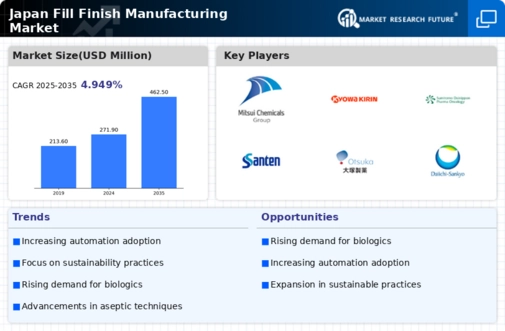Rising Demand for Biologics
The increasing demand for biologics in Japan is a pivotal driver for the fill finish-manufacturing market. Biologics, which include a range of products such as vaccines and monoclonal antibodies, require specialized fill finish processes to maintain their stability and efficacy. The market for biologics was expected to reach approximately $10 billion by 2026, reflecting a robust growth trajectory. This surge in demand compels manufacturers to enhance their fill finish capabilities, adopting advanced technologies such as aseptic processing and single-use systems. Consequently, the fill finish-manufacturing market is evolving to accommodate these complex products, ensuring that manufacturers can meet the specific requirements of biologics while maintaining high standards of quality and safety.
Aging Population and Healthcare Needs
Japan's aging population is a significant driver of growth in the fill finish-manufacturing market. As the demographic shifts towards an older population, there is an increasing prevalence of chronic diseases, necessitating advanced medical treatments and pharmaceuticals. This trend is expected to elevate the demand for injectable drugs and biologics, which require specialized fill finish processes. By 2030, it is estimated that over 30% of Japan's population will be over 65 years old, further intensifying the need for innovative healthcare solutions. Consequently, manufacturers in the fill finish-manufacturing market are likely to expand their production capabilities to meet the rising healthcare demands, ensuring that they can provide effective treatments for an aging populace.
Investment in Research and Development
Investment in research and development (R&D) is a crucial driver for the fill finish-manufacturing market in Japan. As the pharmaceutical industry evolves, companies are increasingly focusing on developing novel therapies and drug formulations. This emphasis on innovation necessitates advanced fill finish processes that can accommodate new product types and delivery methods. In 2025, R&D spending in the pharmaceutical sector is projected to exceed $15 billion, reflecting a commitment to enhancing product offerings. This investment not only fosters technological advancements but also positions manufacturers to respond to emerging trends in personalized medicine and biologics. As a result, the fill finish-manufacturing market is likely to experience growth driven by the continuous pursuit of innovation and excellence in product development.
Technological Integration and Automation
Technological integration and automation are transforming the fill finish-manufacturing market in Japan. The adoption of Industry 4.0 principles, including the Internet of Things (IoT) and artificial intelligence (AI), is streamlining production processes and enhancing operational efficiency. Automated systems reduce human error and increase throughput, which is crucial in a market where precision is paramount. As manufacturers seek to optimize their operations, investments in automation technologies are projected to rise, potentially increasing productivity by up to 30% over the next five years. This shift not only improves the quality of the final product but also positions companies competitively within the fill finish-manufacturing market, enabling them to respond swiftly to market demands.
Regulatory Compliance and Quality Standards
The fill finish-manufacturing market in Japan is significantly influenced by stringent regulatory compliance and quality standards. The Pharmaceuticals and Medical Devices Agency (PMDA) enforces rigorous guidelines to ensure product safety and efficacy. This regulatory landscape necessitates that manufacturers invest in advanced technologies and processes to meet these standards. As a result, companies are increasingly adopting automated systems and quality control measures to enhance production efficiency. The market was projected to grow at a CAGR of approximately 6.5% from 2025 to 2030, driven by the need for compliance with evolving regulations. This focus on quality not only ensures patient safety but also enhances the reputation of manufacturers in the fill finish-manufacturing market, fostering trust among stakeholders.























Leave a Comment